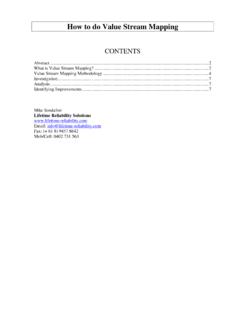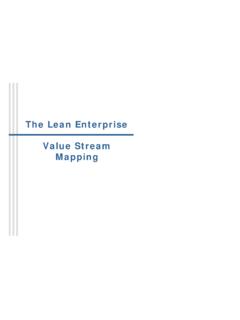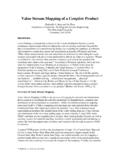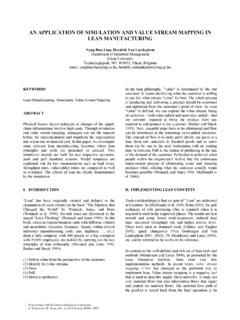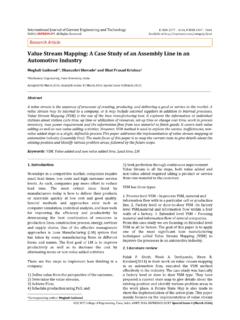Transcription of Product Development Value Stream Mapping …
1 Product Development Value Stream Mapping (PDVSM) Manual Release September 2005 Hugh L. McManus, PhD The Lean Aerospace Initiative Sept. 2005 Product Development Value Stream Mapping (PDVSM) Manual Prepared by: Dr. Hugh L. McManus Metis Design 222 Third St., Cambridge MA 02142 for the Lean Aerospace Initiative Center for Technology, Policy, and Industrial Development Massachusetts Institute of Technology 77 Massachusetts Avenue Room 41-205 Cambridge, MA 02139 The author acknowledges the financial support for this research made available by the Lean Aerospace Initiative (LAI) at MIT, sponsored jointly by the US Air Force and a consortium of aerospace companies. All facts, statements, opinions, and conclusions expressed herein are solely those of the author and do not in any way reflect those of the LAI, the US Air Force, the sponsoring companies and organizations (individually or as a group), or MIT.
2 The latter are absolved from any remaining errors or shortcomings for which the author takes full responsibility. This document is copyrighted 2005 by MIT. Its use falls under the LAI consortium agreement. LAI member companies may use, reproduce, and distribute this document for internal, non-commercial purposes. This notice should accompany any copies made of the document, or any parts thereof. This document is formatted for double-sided printing and edge binding. Blank pages are inserted for this purpose. Color printing is preferred, but black-and-white printing should still result in a usable document. 2005 Massachusetts Institute of Technology 5 TABLE OF CONTENTS ABOUT THIS INTRODUCTION AND Using this LEAN ENGINEERING PROCESS Focus on Engineering Engineering Processes Need Engineering is GETTING Identifying Key Defining the Training the Bounding the EXAMPLE: Getting Defining the METRICS: Output EXAMPLE: Value and Understanding Value METRICS: Value Aspects of EXAMPLE: Value Mapping THE CURRENT STATE Value Basic Advice for Mapping the Current The Zeroth Map (optional).
3 39 EXAMPLE: Zeroth Tasks and Some Process Mapping EXAMPLE: Tasks and Basic Advice for Current State Data METRICS: Task EXAMPLE: Data Evaluation of EXAMPLE: Evaluation of Understanding Iteration: the EXAMPLE: a IDENTIFYING The 2005 Massachusetts Institute of Technology 6 IMPROVING THE Establish a Takt Assure the Availability of Balance the Eliminate Unnecessary or Inefficient Reviews and Break Down Eliminate Unnecessary Eliminate Unnecessary Documents and (Re-) Eliminate Unnecessary Analyses, Exploit Underutilized The Future State BEYOND THE FUTURE The LEM Overarching Practices (OAPs)..76 Millard s Value Stream Analysis Collocation, Boundary Objects, and Shared A Few Good Some Advanced The Ideal State STRIVING FOR APPENDIX A: METHODS AND Research Results: Available Gantt Ward/LEI Process Flow Learning to System Design Structure Matrix (DSM).
4 90 Concluding APPENDIX B: SAMPLE DATA COLLECTION APPENDIX C: SECOND EXAMPLE APPENDIX D: ADDITIONAL Mapping NOTES AND 2005 Massachusetts Institute of Technology 7 ACKNOWLEDGEMENTS This manual is dedicated to the memory of Joyce Warmkessel, a colleague, mentor, and friend to many in the LAI Product Development and Testing and Space Operations communities. The ideas in this work were developed by the LAI Product Development community. The primary compiler and codifier of these ideas was Lt. Rich Millard, in his master s thesis entitled Value Stream Analysis and Mapping for Product Development . 1 Other major contributors included LAI students Tyson Browning,2 Jim Chase,3 Robert Slack,4 and Joshua Bernstein5 and their advisors and committees. Many other LAI students and staff also contributed as well.
5 LAI Product Development research work has been based on, and grounded by, the activities of a very active group of industry practitioners, too numerous to name, who have selflessly shared their hard-won practical knowledge. The text of this manual is built on LAI research and member documents. Much of its contents are excerpts, modifications, or paraphrases of existing work. Every effort has been made to correctly attribute all contributions. Word-for-word excerpts are identified with quotes or indented, with citations. Many other excerpts have been edited to varying degrees and are integrated into the text for clarity. Their sources are cited in the text or in endnotes. Any omissions or errors of attribution should be brought to the author s immediate attention for correction.
6 ABOUT THIS VERSION This version is similar in form and content to the PDVSM Beta release of April 2004. The entire text is revised, and in many places improved, but users of the Beta version will see few surprises. This version does incorporate improvements and additional material in key areas such as metrics and suggestions for improving the Value Stream . The major difference, however, is the higher degree of confidence with which we can make recommendations. This is based on a higher level of maturity of our knowledge of PDVSM, gained through both extensive practical experience and further research. The broad conclusion drawn from the additional studies is that the basic method presented here is effective. The details of these additional studies will not be incorporated here, but this version does incorporate many new references and supporting footnotes, including references to the latest LAI research.
7 2005 Massachusetts Institute of Technology 8 2005 Massachusetts Institute of Technology 9 INTRODUCTION AND SCOPE This manual is intended for Product Development (PD) personnel working on improving their own processes, and the lean change agents working with them. Its aim is to provide practical guidance for applying lean concepts to PD process improvement specifically, PD Value Stream Mapping (PDVSM). Although sources will be cited, and further reading suggested, this manual and some basic background in lean should be all that is required to start improving Product Development processes. This manual is focused on PD process improvement. It is based directly on Lean Aerospace Initiative (LAI) research and member experience. The content is well grounded in research, and (where it exists) theory, and extensive endnotes and references are included.
8 However, it is not an academic monograph. It is an attempt to capture the knowledge and best practices of the LAI PD community to date. PD process improvement is an active and rapidly advancing area of practice, and it is expected that periodic updates to this manual will be required. The LAI PD community would be delighted to know if your practices reinforce, contradict, or have moved beyond the content of this manual. Scope The scope of this manual is limited to the Mapping and improvement of a single, definable Product Development process, as shown in Figure 1-1. It will show you how to map this process door to door. It will then help you find the wastes, inefficiencies, and non- Value -added actions that can be eliminated quickly to achieve a future state, and give you insight into the possible ideal state that should serve as a longer-term goal.
9 Figure 1-1. PDVSM applies to a definable process within the Product Development Value Stream ENTERPRISE Value Stream Product Development Value Stream YOUR PROCESS INDIVIDUAL TASK PDVSM 2005 Massachusetts Institute of Technology 10 The manual will concentrate on processes on the scale of component-level hardware Development . The wording of the text and examples is hardware-centric, but the intent is to be useful for any Development process with a similar scale. The method should apply to many other off-the-factory-floor processes, including but not limited to software Development , service or maintenance processes, information-handling office processes, and decision-making processes such as requirements generation. Some translation of terms and recasting of examples will be necessary in these contexts, however.
10 Some of the wording is also cast in terms of new Product Development . This does not imply a bias towards new Development ; on the contrary, much of the member experience in PDVSM is in program-support areas such as drawing changes initiated on the factory floor, or modifications of existing products. Using this Manual This manual is not intended to instruct you in basic lean principles Womack and Jones Lean Thinking6 is the seminal introductory work, and basic familiarity with the ideas therein is assumed. The basic concept of Value Stream Mapping (VSM) is introduced in Lean Thinking, with examples based on the production of physical products. VSM as practiced in lean manufacturing, is expanded in detail in Rother and Shook s Learning to Familiarity with this work is highly recommended.
